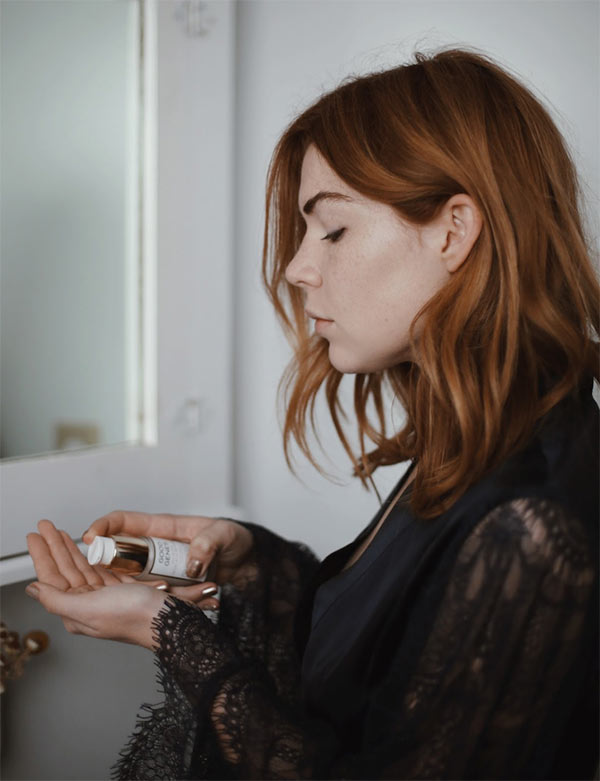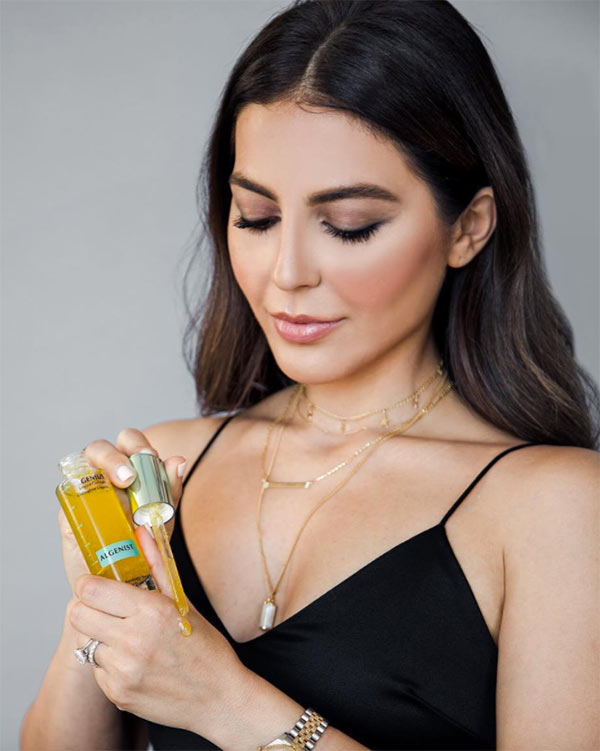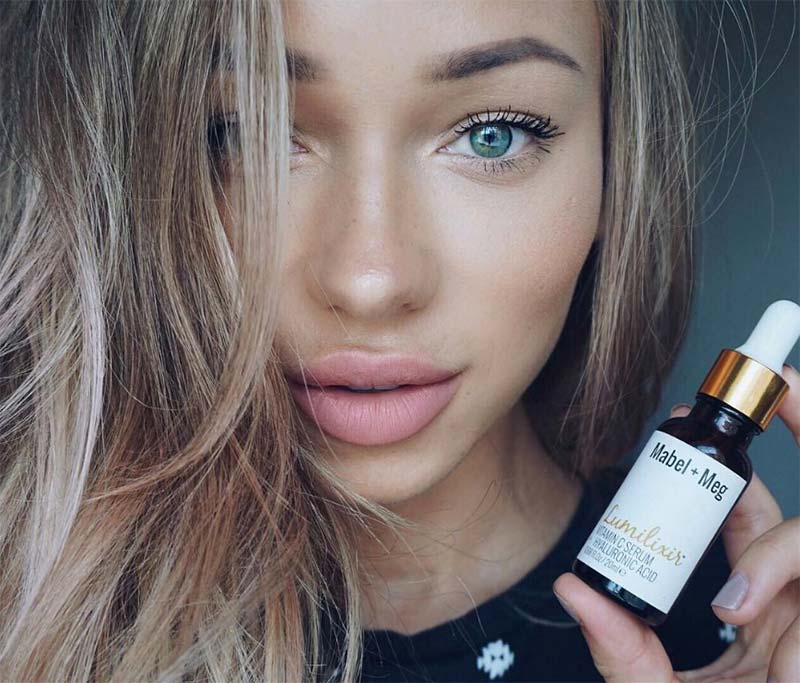Good face serums are worth their weight in gold. Face serums are those pesky skincare products that are not really toners and are not really moisturizers. They cause a bit of confusion, but that’s why I’ll be clarifying their purpose for you. These rich liquids are skincare supplements – the role of serums is to cover the concerns your moisturizer isn’t treating in a powerful way since they don’t have the double role of treating and moisturizing.
To help you figure out whether you should use a serum (tl;dr yes!), and if so, which one, I put together this article. I explain exactly what skin serums are and how they work, and I’ll help you choose the best serums for you, best on your skin type and concerns. I also have some handy tips and tricks, so you can get the most out of your face serums!
In this article:
- What Are Face Serums and Why Should They Be Used?
- Serums vs. Face Oils – What’s the Difference?
- How to Choose the Best Face Serum for Your Skin Type
- How to Choose the Best Face Serum for Your Skin Concerns
- How to Use Face Serums
- Face Serum Tips & Tricks
What Are Face Serums and Why Should They Be Used?
Face serums are leave-on skincare products that come in the form of a thick liquid. Since they are thinner than moisturizers, they penetrate into the skin faster, and end up reaching deeper than a moisturizer would. This makes them a more ideal delivery system for potent actives than a lotion or cream.
Serums (also body serums) are a perfect addition to almost anyone’s beauty routine, since we can all benefit from a boost of protective antioxidants and hydrators. These kinds of ingredients are more effective in the form of a serum, and they can slow down the skin aging process while also strengthening and moisturizing the skin. Since most skin serums are water based, they are beneficial for both oily and dry skin types.
Those with more specific skin concerns can choose serums that do more than just provide nourishment and protection. They can choose serums with specialized ingredients that will help with their specific needs. In the light formula of a face serum, these ingredients will likely do a better job!
Serums vs. Face Oils – What’s the Difference?
Many people that have never used face serums often end up wondering what the difference between serums and face oils is. It’s very easy to differentiate serums from face oils, and it all is due to the single ingredient they may or may not contain – water!
Skin Serums Are Water-Based
The majority of face serums are water-based, meaning that the first ingredient on their list of ingredients is water. This makes their texture light and liquidy (although not as fluid as a toner or face mists), and it allows them to sink into the skin very quickly.
In this water-based formula, lots of potent skincare ingredients can be dispersed, and it is the best way to hydrate the skin and fight all kinds of unique concerns.
Facial Oils Are Water-Free
In my opinion, oil-based serums should not count as serums. There. I said it. Fight me, marketing teams!
Bare in mind, this doesn’t mean that I don’t like these products – I think oil-based formulas are phenomenal for the skin! I just think that it is better to call these face oils, and be done with it.
Unlike water-based face serums, facial oils contain no water. They have a thicker, oilier texture, and they take much longer to sink into the skin. They don’t provide the skin with water, so they don’t hydrate it. Instead they create a barrier over the skin, preventing moisture from escaping.
Face oils are best used at the end of the skincare routine to lock in all of the goodness in the water-based products you use. They are wonderful additions to the routine of anyone with dry skin, although some face oils are light and non-comedogenic and are therefore loved by oily and normal skin types as well.
How to Choose the Best Face Serum for Your Skin Type
I want to start with a quick reminder: skin type refers to the amount of oil your skin produces.
Pay attention to how shiny your skin gets throughout the day, on days when you don’t wear makeup. If your skin is very shiny by mid-day, then you have an oily skin type. If your skin remains matte, then you are dry. Most people land somewhere in between with normal or combination skin.
You can also determine your skin type by examining your pores: larger pores tend to correspond with an oilier skin type, while smaller pores correspond with a drier skin type. The exception is that as we age, sometimes our pores remain a little larger, even though our skin becomes dry.
Once you’ve determined your skin type, here is how you can choose the right serum for you!
Face Serums for Normal Skin
Chances are most face serums will work well with your skin! You might want a simple hydrating and protective serum with antioxidants and humectants, or you may choose a serum with specific ingredients to target specific skin concerns you might have.
Face Serums for Combination Skin
There are a few ways you can use serums to get your skin balanced. You can use one serum all over the face that has hydrating properties (and perhaps some additional properties to target your specific skin needs). Then, follow it up with moisturizer only on the drier parts of your face.
You can also use one light serum on the oily parts of your face, and a richer serum only on the parts of your face where you are dry.
Face Serums for Dry Skin
Your skin type thrives with face serums, and the more the better! In fact, layering serums and moisturizers is likely the best way to get your skin super hydrated and moisturized from top to bottom.
Opt for serums with blends of humectant ingredients like glycerin and hyaluronic acid, along with a few occlusive ingredients like botanical oils. Skin-repairing antioxidants and ceramides will also make a big difference!
Face Serums for Oily Skin
Those with oily skin can actually use serums instead of moisturizers! If the serum you like has lots of hydrating ingredients, it might give your skin enough moisture and render creams and lotions unnecessary.
Serums with niacinamide, specifically, will greatly help to control and minimize the amount of oil your skin produces. You might want to avoid finishing face serums that are oil-based.
How to Choose the Best Face Serum for Your Skin Concerns
Skin concerns are where serums can make radical differences, because they can really feed the skin with active ingredients and make radical changes.

Anti-Aging Face Serums
There are so many incredible anti-aging ingredients out there that it can be hard to choose from. While many fancy sounding ingredients might sound good, the strongest proven ingredients are peptides and vitamin A. Other vitamins will provide antioxidant protection which is very useful, and the addition of plant extracts and oils could boost it as well.
Additionally, as we age, our skin starts to lose hydration, so humectants like panthenol and hyaluronic acid will make a big difference. If you want an exfoliating serum, then lactic acid is your friend here, since it exfoliates gently without drying out the skin.
Face Serums for Hyperpigmentation & Dark Marks
There are many skin-brightening serums out there, because serums are probably the best way to deliver those agents to the skin. Look for ingredients like vitamin C, vitamin A, licorice root extract, mulberry extract, arbutin, and alpha lipoic acid to brighten your skin, as well as to rejuvenate it and fight premature aging.
Exfoliation also makes a big difference for fading pigmentation, and glycolic acid tends to be the best for dark marks.
Face Serums for Dehydration
Serums are amazing at replenishing the skin with water. You want to find for yourself face serums rich in humectant ingredients like hyaluronic acid, panthenol, and glycerin. Gentle antioxidants like vitamin E will also help repair your skin and prevent moisture from evaporating.
Face Serums for Acne & Clogged Pores
Skin serums can deliver all kinds of ingredients to improve the look of acne-prone skin. Salicylic acid is an exfoliant that can unclog pores while fighting the inflammation so common with breakouts.
In general, anti-inflammatories are key here to reduce the pain, redness, irritation, and swelling caused by acne, so have no fear of water-based ingredients like green tea extract or willow bark extract.
Face Serums for Scarring & Uneven Skin Texture, Sensitivity & Redness
Soothing botanical extracts can immediately improve your skin tone and calm your irritation. Calendula and green tea are the first extracts to come to mind.
Additionally, skin that has been fortified with antioxidants and humectants will generally be stronger and more resistant to irritation, so look for the same ingredients that will repair dehydrated skin.
How to Use Face Serums
Depending on the face serums you choose, you might want to include them in different parts of your routine. However, what is always true is that a real serum (i.e. a water-based serum) should always go on the skin at some point after cleansing, and before moisturizing.
The following order outlines all of the places where a serum might fall into your routine:
- Cleanse
Cleanse your skin ideally with a face wash with a pH below 5.6. You may also choose to double cleanse or do an oil cleanse. Make sure to cleanse every evening, although it’s an optional step in the morning.
- Apply a Toner
Apply a pH-adjusting toner, especially if you are going to be using pH-dependant actives, or if your cleanser has a pH higher than 5.6. If your cleanser is gentle and pH balanced, then a toner is optional.
- Apply Your Serum
Apply face serums that contain pH-dependant actives like vitamin C, salicylic acid, or glycolic acid. You can apply them either by pressing them into the skin with the beds of your fingers, or using a clean foundation brush. If you can, let each one of these actives sit on the skin for around 10-20 minutes before applying the next layer.
- Apply Hydrating Skincare
Now you may apply hydrating layers of skin care. This can include hydrating toners and facial essences.
- Apply Your Other Serums
Next, apply your skin serums that are not pH-dependant. If you only use one serum, go ahead and put it on! If you have multiple serums that you would like to use, first apply the ones with thinner, more liquid-y texture. Thicker or oilier serums can be applied afterwards.
To apply, squeeze a couple drops of serum into your hands. Using the pads of your fingers, press the serums into your skin without rubbing too hard – they will become absorbed quickly. If you do feel the need to massage them in a bit, do so gently in circular, upward motions, to ensure optimal penetration. - Moisturize
Finish off with your favorite moisturizer, applying it much in the same way as you did the serum. If you have oily skin, or your serum is very moisturizing, then you can actually skip the moisturizer!
- When Your Serum Is Water-Free…
So while in my opinion calling these kinds of products serums is misleading, I can’t help what the beauty industry does. If you have a water-free serum that is composed of oils or silicones, you should apply it to your skin after moisturizer. Water-free formulas are usually occlusive, so they help lock moisture into the skin, even if their texture is fluid.
- Apply SPF
If it is daytime, make sure to apply at least a ¼ teaspoon of sunscreen to your skin, especially if you use products with exfoliating actives like glycolic acid.

Face Serum Tips & Tricks
- If you’re in a rush, or you don’t like the multiple skincare steps, you can still enjoy the benefits of a serum. Squeeze out a drop of serum and mix it with your moisturizer right before applying, to boost the amount of active ingredients your skin receives! Don’t do this with pH-dependant serums with vitamin C or exfoliating acids and avoid doing it with a day cream with SPF since the serum will dilute the efficacy of the sunscreen.
- It is important to know which serums belong when. Resurfacing actives like glycolic acid and retinol are best in the evening, since they make the skin more sensitive to sun exposure. Antioxidant skin serums, on the other hand, are best in the daytime because they boost the efficacy of your sunscreen and keep your skin looking younger for longer.
- While it might be tempting to make a custom blend of all the serums and moisturizers you have in your arsenal, remember that each product had to be crafted delicately by a professional. Mixing face serums in the hand right before applying it is usually safe, but don’t become your own chemist or you will disrupt the products’ preservative system and put your own health at risk.
- Skin-soothing and hydrating face serums are perfectly safe to put around the eyes! Layer them under your eye cream for a hydrating boost. Active serums, on the other hand, should be used with care. The retinoids and acids that will radically transform your face are likely to be too harsh for the delicate eye area.
- Give your neck and chest the same love you give your face! Those serums that make your skin look so good will also keep your neck and chest looking healthy and smooth.
Are you using face serums in your skincare routine? Which ones? Share your favorites!
Photos via @liza_lash, Instagram





